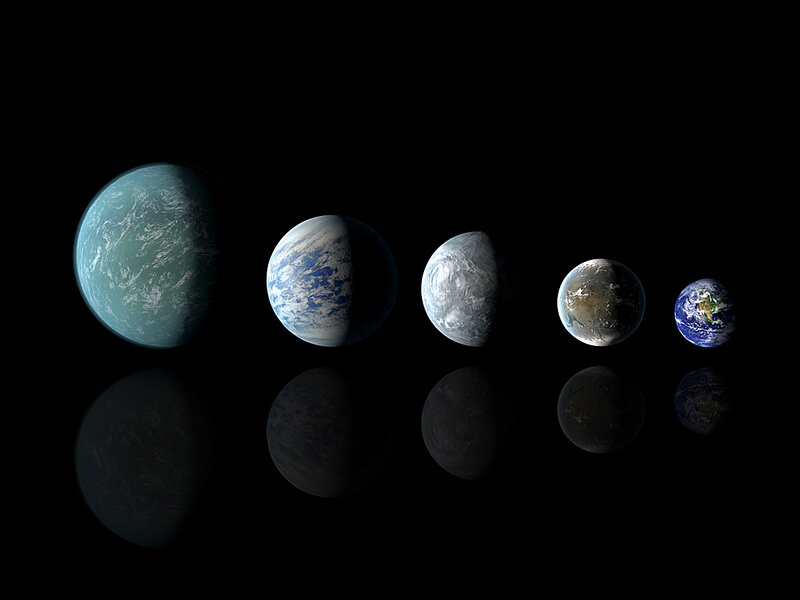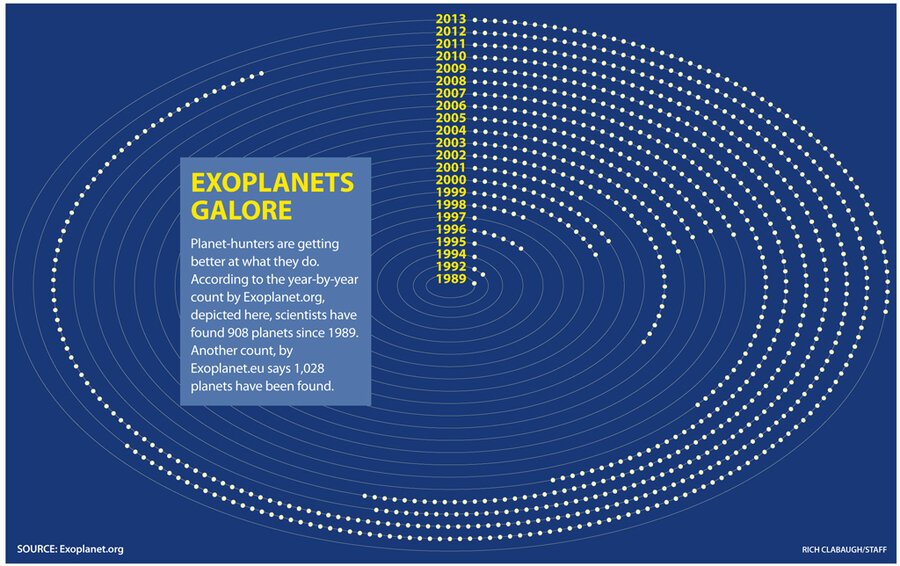The hunt for other 'Earths': Are we getting closer?
Loading...
For at least 2,500 years people have speculated about worlds beyond Earth capable of sustaining life. Aristotle said: No way. Epicurus said: Way. Humans have been arguing about it ever since.
Now, scientists have reached a milestone, of sorts. According to one tally, they have found 1,000 planets beyond the solar system, with 3,600 more candidates. Of the 1,000 confirmed, 12 have the potential for supporting at least simple forms of life, scientists say. Three could hold more-complex forms of life.
It is an astounding haul considering that the search for extrasolar planets, or exoplanets, is, by many measures, only 25 years old. For the moment, the holy grail of this search remains elusive. Scientists cannot yet point to an Earth-mass planet orbiting a sunlike star at Earth-like distances. But that day might not be so far off.
Planet-hunting techniques, know-how, and technology have advanced so steadily that astronomers could find another planet like Earth within a decade, one scientist suggests.
"If you want to talk about true Earths, we could be 10 years off" from finding one "if we had money and built what we wanted to," says Sara Seager, an astronomer at the Massachusetts Institute of Technology (MIT), who is working on concepts for a space telescope designed to image planets orbiting nearby stars.
The potential is intriguing. Some 11 percent of sunlike stars in the galaxy host a planet between one and two times the size of Earth, located at a distance from which it receives from one to four times more of its star's energy than Earth does from the sun, according to an estimate by a team of scientists with the National Aeronautics and Space Administration's Kepler mission. If that percentage turns out to be closer to 22 percent, the researchers say, the nearest of these planets could be a scant 12 light-years from Earth, orbiting a star close enough for humans to spot without the aid of a telescope.
That's close enough for a new generation of space telescopes to determine if it's there, if it has the right stuff for life to take hold, and, if it has an atmosphere, whether that atmosphere bears telltale signs of biological activity.
In some ways, science has already prepared earthlings for the prospect that we are not alone. Biologists have discovered organisms that thrive in extreme conditions of heat, cold, acidity, and even high levels of radiation – conditions once thought hostile to life. Planetary exploration within our solar system has revealed potential habitats for such organisms.
Still, "there's a difference between thinking that it might exist and finding out that it actually does," says Steven Dick, former chief historian at NASA who now holds the Baruch S. Blumberg NASA/Library of Congress Chair in Astrobiology.
A quarter-century ago, the question was not "When will we find another Earth," so much as, "When will we find any planet at all?"
"I remember a meeting long ago when people were nervously shifting from one foot to another, saying, Why haven't we found any planets? What if there aren't any other planets around other stars?" says Debra Fischer, a Yale University astronomer who has discovered exoplanets and is working on a new generation of planet-hunting spectrometers for ground-based telescopes.
The two methods used to find planets
An early inkling that finding an exoplanet might be possible emerged in 1953, when astronomer Otto Struve of the National Radio Astronomy Observatory in Virginia noted that spectrometers should be able to detect a planet some seven times Jupiter's mass if it orbited close to its host star.
A decade later, astronomer Peter van de Kamp reported finding a Jupiter-class planet orbiting Barnard's Star, a red dwarf six light-years from Earth. His claim was eventually rejected, but it marked the beginning of a refinement of the planet-hunters' toolbox.
Although astronomers use several approaches to find exoplanets, two have been the most productive. One method is looking for wobbles in a star's spectrum, or chemical signature encoded in the starlight, as a planet tugs the star to and fro with each orbit. Another involves hunting for the extremely faint shadow planets cast as they pass in front of host stars.
Of all the discoveries since the first confirmed planet orbiting a sunlike star was reported in 1992, two come closest to Earth in size or mass – a planet 13 percent more massive than Earth orbiting Alpha Centauri B some 4.3 light-years away, and Kepler-78b, orbiting a star 400 light-years away. It's 12 percent larger than Earth and at least 69 percent more massive. Both are orbiting their stars far closer than the stars' habitable zones extend. Indeed, Kepler-78b is so close to its star that it's probably a molten planet.
The sheer range of planetary systems itself has been an eye-opener, suggesting that our home system may be relatively rare. One system hosts five planets arranged like a club sandwich – two planets comparable in size to Earth tucked between three planets somewhat smaller than Neptune. All five fall within a 29- million-mile belt around their host star – a belt that would fit inside Mercury's orbit.
What a space telescope may find
This diversity of solar systems points to an enormous number of planets. Data from the Kepler spacecraft suggest that there is at least one planet for each of the Milky Way's 100 billion or more stars. And the galaxy appears to host many more small planets than large ones.
But how many Earths might be among them? There remains some uncertainty, even with the latest estimate based on the Kepler mission's observation.
"Right now, you could say that 1 in 5 stars like the sun have an Earth. But you could also say 1 in 3, or maybe it's 1 in 10," says MIT's Dr. Seager. "That means we know they are probably very common."
Answering that question more conclusively is crucial to the search for a potentially habitable planet like our own.
In planning the smallest, least expensive mission possible to loft a space telescope dedicated to finding and studying some of these planets, "we want to know if we're going to find a few or not find any," she adds.
Meanwhile, in 2017, NASA plans to launch the Transiting Exoplanet Survey Satellite (TESS), which will use the dip-in-starlight method to observe about 500,000 stars. The team estimates that they should be able to identify 1,000 to 10,000 planets as large as or larger than Earth on orbits that take two months to complete.
Dr. Fischer leads a team striving to improve the ability of spectrographs to spot the tiny wobble that planets impart to their host stars. The goal is to have the technology operating on a ground-based telescope outside Flagstaff, Ariz., operated by the Lowell Observatory, in time to work with TESS to identify the types of planets TESS discovers, in addition to uncovering planets on its own.
Of course, the impact of potentially finding evidence for life elsewhere in the cosmos depends on the circumstances surrounding the discovery, suggests Dr. Dick of the Library of Congress. Societies could probably take in stride the discovery of microbial life, he says.
Reshaping our views of the universe
But the discovery of advanced forms of life – and communication with them – could reshape our views of ourselves and the universe. How different is our knowledge from their knowledge, and is there overlap? How objective are our perceptions of the world?
That prospect remains distant, in all likelihood, but as astronomers refine their ability to find planets and interpret data, the search for another Earth becomes more promising.
"We'll get better at the observations and interpretation of signatures of life," says Ben Bromley, an astronomer at the University of Utah in Salt Lake City.
"We'll get a good picture of the neighborhood, and we may be able to see if any of the neighbors are like us," he says.







